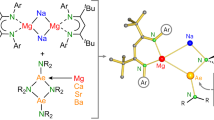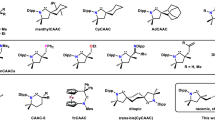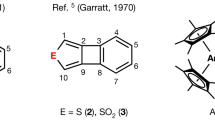Abstract
THE stereochemistry of four-covalent nickel(II) complexes has been a subject of great interest to chemists for the past two decades. Following the enunciation of Pauling's theories relating stereochemistry, bonding orbitals and magnetic moment, it has been shown that, in all cases where structural studies have been carried out, the diamagnetic four-covalent complexes of nickel(II) are square planar1. However, little work has been done to investigate the structure of the paramagnetic (presumably) four-covalent complexes such as bissalicylaldehyde-nickel(II) and bisacetylacetonenickel(II). These complexes have a magnetic moment indicating two unpaired electrons2 and usually this has been assumed, without proof, to indicate that 4s tetrahedral bonding occurs. It has been shown by Curtiss, Lyle and Lingafelter3 that the X-ray powder patterns of bissalicylaldehydenickel(II) and of its zinc analogue are identical. This has been taken as evidence in support of a tetrahedral arrangement of the four oxygen atoms around the nickel(II) atom because zinc(II) is known to display tetrahedral co-ordination. However, in the absence of definite proof that the zinc(II) atom has tetrahedral co-ordination in this instance, the case is not proved. It was decided, therefore, to carry out an X-ray investigation of bisacetylacetonenickel(II) and the preliminary results are summarized here.
This is a preview of subscription content, access via your institution
Access options
Subscribe to this journal
Receive 51 print issues and online access
$199.00 per year
only $3.90 per issue
Buy this article
- Purchase on Springer Link
- Instant access to full article PDF
Prices may be subject to local taxes which are calculated during checkout
Similar content being viewed by others
References
See, for example Godycki, L. E., and Rundle, R. E., Acta Cryst., 6, 487 (1953). Cox, E. G., Wardlaw, W., and Webster, K. C., J. Chem. Soc., 1475 (1935).
Mellor, D. P., and Craig, D. P., J. Proc. Roy. Soc., N.S.W., 74, 475 (1940).
Curtiss, D. H., Lyle, F. K. C., and Lingafelter, E. C., Acta Cryst., 5, 388 (1952).
Howells, E. R., Phillips, D. C., and Rogers, D., Acta Cryst., 3, 210 (1950).
Author information
Authors and Affiliations
Rights and permissions
About this article
Cite this article
BULLEN, G. Trinudear Molecules in the Crystal Structure of Bisacetylacetonenickel(II). Nature 177, 537–538 (1956). https://doi.org/10.1038/177537a0
Issue Date:
DOI: https://doi.org/10.1038/177537a0
This article is cited by
-
Octahedral Co-ordination of Nickel in Nickel(II) Bisacetylacetone
Nature (1961)
-
Electron diffraction study of the crystal structures of internal complex nickel and copper compounds of salicylalimine and its derivatives
Journal of Structural Chemistry (1961)
-
Similarities and differences of crystal structure of internal complex compounds of copper and nickel
Journal of Structural Chemistry (1961)
-
Present state of the crystal chemistry of complex compounds
Journal of Structural Chemistry (1961)
-
Stereochemistry of Complex Halides of the Transition Metals
Nature (1958)
Comments
By submitting a comment you agree to abide by our Terms and Community Guidelines. If you find something abusive or that does not comply with our terms or guidelines please flag it as inappropriate.



